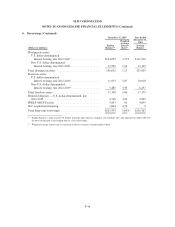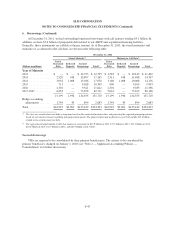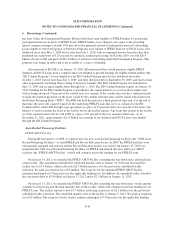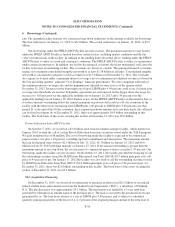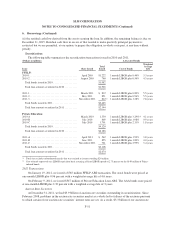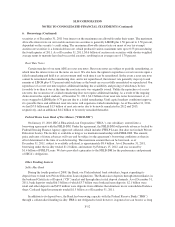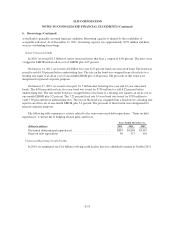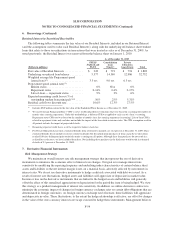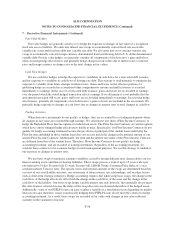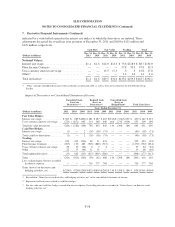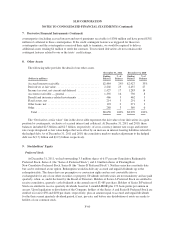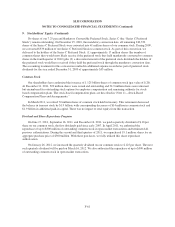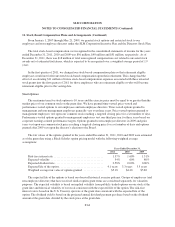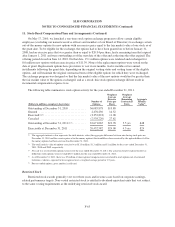Sallie Mae 2011 Annual Report Download - page 165
Download and view the complete annual report
Please find page 165 of the 2011 Sallie Mae annual report below. You can navigate through the pages in the report by either clicking on the pages listed below, or by using the keyword search tool below to find specific information within the annual report.SLM CORPORATION
NOTES TO CONSOLIDATED FINANCIAL STATEMENTS (Continued)
7. Derivative Financial Instruments (Continued)
Fair Value Hedges
Fair value hedges are generally used by us to hedge the exposure to changes in fair value of a recognized
fixed rate asset or liability. We enter into interest rate swaps to economically convert fixed rate assets into
variable rate assets and fixed rate debt into variable rate debt. We also enter into cross-currency interest rate
swaps to economically convert foreign currency denominated fixed and floating debt to U.S. dollar denominated
variable debt. For fair value hedges, we generally consider all components of the derivative’s gain and/or loss
when assessing hedge effectiveness and generally hedge changes in fair values due to interest rates or interest
rates and foreign currency exchange rates or the total change in fair values.
Cash Flow Hedges
We use cash flow hedges to hedge the exposure to variability in cash flows for a forecasted debt issuance
and for exposure to variability in cash flows of floating rate debt. This strategy is used primarily to minimize the
exposure to volatility from future changes in interest rates. Gains and losses on the effective portion of a
qualifying hedge are recorded in accumulated other comprehensive income and ineffectiveness is recorded
immediately to earnings. In the case of a forecasted debt issuance, gains and losses are reclassified to earnings
over the period which the stated hedged transaction affects earnings. If we determine it is not probable that the
anticipated transaction will occur, gains and losses are reclassified immediately to earnings. In assessing hedge
effectiveness, generally all components of each derivative’s gains or losses are included in the assessment. We
generally hedge exposure to changes in cash flows due to changes in interest rates or total changes in cash flow.
Trading Activities
When derivative instruments do not qualify as hedges, they are accounted for as trading instruments where
all changes in fair value are recorded through earnings. We sell interest rate floors (Floor Income Contracts) to
hedge the Embedded Floor Income options in student loan assets. The Floor Income Contracts are written options
which have a more stringent hedge effectiveness hurdle to meet. Specifically, our Floor Income Contracts do not
qualify for hedge accounting treatment because the pay down of principal of the student loans underlying the
Floor Income embedded in those student loans does not exactly match the change in the notional amount of our
written Floor Income Contracts. Additionally, the term and the interest rate index of the Floor Income Contracts
are different from that of the student loans. Therefore, Floor Income Contracts do not qualify for hedge
accounting treatment, and are recorded as trading instruments. Regardless of the accounting treatment, we
consider these contracts to be economic hedges for risk management purposes. We use this strategy to minimize
our exposure to changes in interest rates.
We use basis swaps to minimize earnings variability caused by having different reset characteristics on our
interest-earning assets and interest-bearing liabilities. These swaps possess a term of up to 15 years with a pay
rate indexed to 91-day Treasury bill, 52-week Treasury bill, LIBOR, Prime, Consumer Price Index or 1-year
constant maturity Treasury rates. The specific terms and notional amounts of the swaps are determined based on
a review of our asset/liability structure, our assessment of future interest rate relationships, and on other factors
such as short-term strategic initiatives. Hedge accounting requires that when using basis swaps, the change in the
cash flows of the hedge effectively offset both the change in the cash flows of the asset and the change in the
cash flows of the liability. Our basis swaps hedge variable interest rate risk; however, they generally do not meet
this effectiveness criterion because the index of the swap does not exactly match the index of the hedged assets.
Additionally, some of our FFELP Loans can earn at either a variable or a fixed interest rate depending on market
interest rates and, therefore, swaps economically hedging these FFELP Loans do not meet the criteria for hedge
accounting treatment. As a result, these swaps are recorded at fair value with changes in fair value reflected
currently in the statement of income.
F-56


